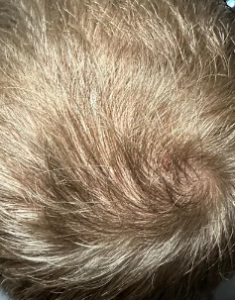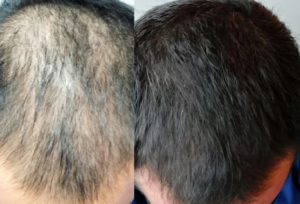I’ve seen a lot of talk around dermarolling and topical minoxidil application. My question is if I am already on 1mg fin and 5mg oral minoxidil a day, is there a benefit to dermarolling without topical application?Is there an argument to supplement oral minoxidil w/ topical minoxidil regularly? What about right after dermarolling say once a week?
It is not unusual for some men, even older men like this 48-year-old male, to find finasteride reversed his hair loss in just 11 months. I have seen this far more often than seeing any frontal hair loss reversal in men over 30. Many men who have never tackled their crown loss and are willing to try finasteride may get a reversal of the crown balding, as shown in these photos.
Dutasteride is not FDA-cleared for use on hair loss. It also has a very long half-life of 5-6 weeks in the bloodstream and many, many months in your body. That means if you develop side effects and stop the medications, the side effects can last up to a year. Finasteride, on the other hand, has a bloodstream half-life of 4-6 hours, and if you stop it, it will be out of your system in weeks, not months. The FDA also cleared finasteride for hair loss use.
https://www.dailymail.co.uk/health/article-12804951/Stop-balding-process-injecting-body-fat.html
Although this is not a scientific paper, we know that body fat contains stem cells, so it is not unreasonable to expect that injecting fat cells into a scalp might stimulate hair growth. I would imagine, however, that these hairs will require continuous injections to keep them there. The hair that grows is indeed the original native hairs whose stem cells were still present. Unlike a hair transplant that brings genetically lifetime hairs to the balding area, these hairs will likely require continuous injections to keep them growing.
Man on here I only see „3 months progress fin/min“ and those guys always transform from nw6 to a full nw1. I am currently 3 months on fin about 5 on min and I am not sure if I have any results (diffuse thinning). Maybe I am shedding maybe not i dont even fking now anymore diffuse thinning your hair looks one day great and the next day like you are bald as fck. Just wanted some reasureance if anyone of you still saw great results afterwards bc I am becoming insane.
Many times, it takes up to a year to see the results from finasteride. Finasteride always works either by slowing, stopping, or reversing the hair loss. Be patient.
My derm prescribed me 1mg oral minoxidil as they wanted to evaluate the effects of the drug for a month before they increase the dose. I am wondering if 1mg is effective enough and if anyone has seen results when taking 1mg? I currently use topical minoxidil 2 times a day.
Since 60% of men will not respond to topical minoxidil, the oral works on 100% of men. The 1mg dose is a reasonable starting dose. Your dermatologist knows what she is doing.
This man wants advice on which medications and actions he can take to get hair to regrow. This was my response: “Without knowing your age, I can’t tell what is the best approach to trying to regrow your hair. If you are over 30, it would be unlikely even with oral minoxidil in combination with finasteride would be my suggestion. I would add microneedling weekly to this mix. The miconeedling produces a very different stimulus for hair growth and this combination has grown hair on even men over 30 at times. Even if you are successful, what we don’t know is how long this success will last.
A hair transplant remains an option as well, but you have to have your donor density and your hair mass measured before you will understand what is possible for a man with your hair loss pattern.”
I’m 22 and have been thinning at the hairline and a little on the crown for years. Still have my hairline somehow (very very thin, used to be thick as when I was 20). I started fin a few days ago. It feels so good that I am at least doing something to stop the balding progress. If I see no progress, at least I’ll have the satisfaction of trying. I’ve been using minoxidil only on my beard and hope to not use it on my scalp any time soon.
I suspect that you will see value in what you are doing. You are doing the right thing!
hi i have been on 1.25 mg finasteride and 10 mg oral minoxidil (liquid), and i got really great results but I decided to stop oral minoxidil and continue using finasteride minoxidil gives me muscle pain and damaged my jawline. If I stop the minoxidil, will there be shedding? How long will it last?
The dose of oral minoxidil is too high, so if you are getting side effects. I would reduce the dose to 1.25mgs. It is stopping minoxidil entirely which produces the risks of losing all of the benefits, which might be the hair that grew due to the medication. High doses of minoxidil produce many risks to your health and your present problem is included in this assessment.
Doc what would you say the success rate of oral minoxidil is? Will it reverse the loss of my widow’s peak?
Hair growth occurs with oral minoxidil. This hair growth is not restricted to the scalp and that is the problem for this drug in women who don’t want body or facial hair. The widow’s peak rarely recovers with minoxidil.
How do you tell the difference between “age related thinning” vs diffuse thinning from genetic balding?
You can tell the difference because the hair shaft thickness exists everywhere uniformly with ‘age-related thinning’, even those hairs in the back of the head.
Here are two examples that I would like you to comment on
1.someone took finasteride from 25 years old to 40 years old, then stopped taking it.
2.that same person never took finasteride.
Who will have more hair at 50 years old? what Im basically trying to figure out is what’s better for your hair, taking finasteride then stopping completely, or never taking it in the first place? thanks!
The studies are clear from Merck. Men who take finasteride will have less hair loss over time. I have seen this in my practice, when men on finasteride who stop it, regardless of age, lose hair within the first 3 months and that loss can be dramatic. I have had men on finasteride for 20+ years and if they stop it, they always lose their natural hair that was held in place by finasteride.



